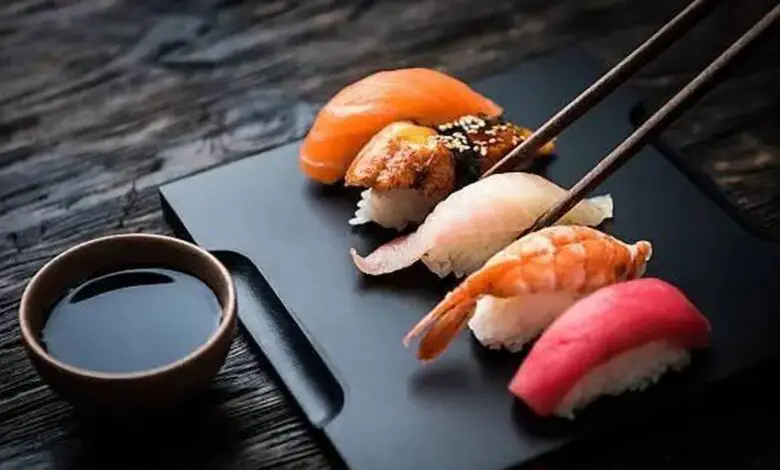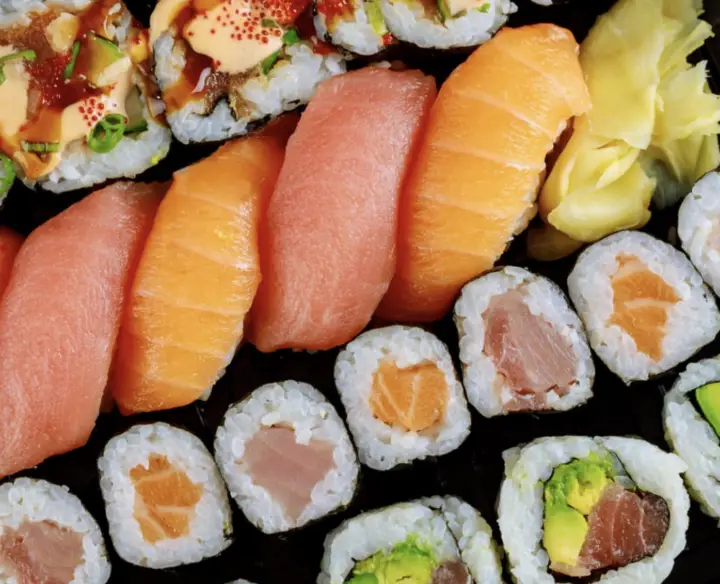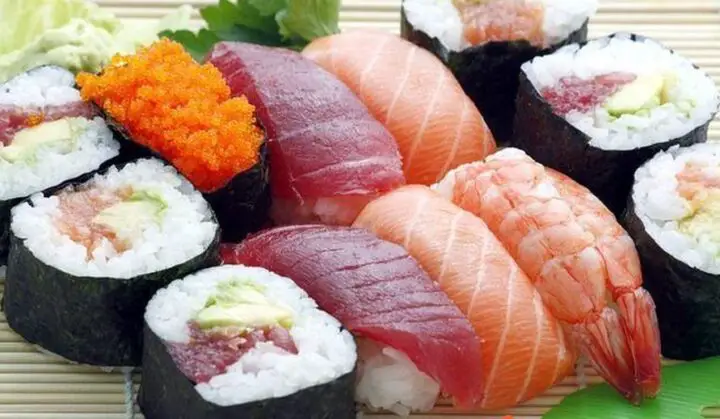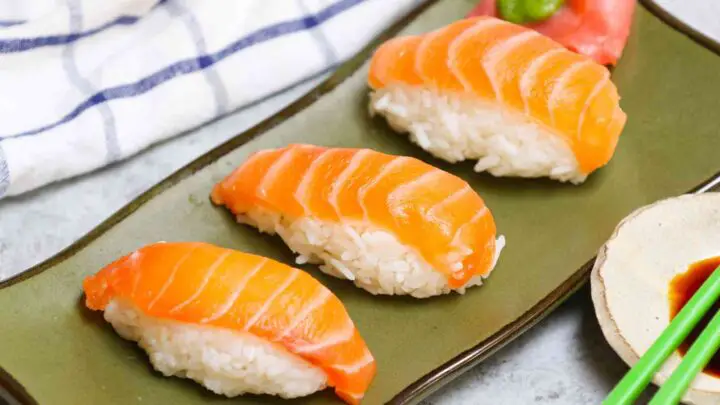Sushi vs Nigiri vs Sashimi: What’s The Difference?

Step into the captivating world of Japanese cuisine, where sushi reigns supreme and entices even the most seasoned sushi lovers. Amidst the myriad variations lies a realm of confusion, but fear not! Let’s unravel the secrets that set sushi, nigiri, and sashimi apart.
Picture this: hand-pressed sushi rice, delicately topped with thin slices of raw fish in nigiri. And then, there’s sashimi – pure, unadorned, and utterly divine. With fresh, high-quality seafood and a rich tradition rooted in Japanese culinary art, these delicacies will transport you to a realm of pure delight. Get ready to embark on a mouthwatering journey through the wonders of Japanese gastronomy!
“Sushi” Means & The Most Popular Types of Sushi

Sushi, a term often used synonymously with Japanese cuisine, refers to any dish made with vinegared rice, known as sushi rice, which can be paired with various toppings, fillings, and condiments. Hanaya Yohei, credited as the pioneer of modern sushi, developed the fast food version in the 19th century, which quickly became popular. The most commonly known types of sushi include Maki, a roll of sushi rice and filling wrapped in seaweed (nori), and Nigiri, a hand-pressed sushi made of sushi rice topped with a thin slice of raw fish or seafood. Additionally, there is Sashimi, which is simply fresh raw fish or seafood served without rice. Each type of sushi offers a unique experience for sushi lovers, with varying flavors, textures, and presentation styles. It’s important to remember that sushi is not just about the taste but also the artful and meticulous preparation by skilled sushi chefs, making it a favorite in Japanese food culture worldwide.
What is Nigiri?
Nigiri, a true gem in Japanese sushi, is a culinary masterpiece. Picture a small, artfully crafted mound of seasoned sushi rice topped with a delicate slice of fresh, raw fish or seafood. The name ‘nigiri’ speaks volumes – it means ‘hand-pressed,’ a testament to the traditional preparation method where skilled sushi chefs expertly mold the rice with their bare hands before placing the exquisite seafood on top. From succulent bluefin tuna to luscious salmon, these delectable toppings may be lightly brushed with soy sauce or adorned with a touch of wasabi and a strip of nori (seaweed). The exquisite balance between the slightly sweet, vinegar-kissed rice and the pristine, raw seafood creates a symphony of flavors and textures that will transport any sushi lover to pure bliss.
What is Sashimi?
Sashimi takes the Japanese culinary artistry to its minimalist, yet bold, expression. Unencumbered by rice or seaweed, sashimi is the purest form of enjoying fresh, raw seafood like tuna, salmon, or even more exotic choices like octopus, all selected for their superior quality and freshness. The term ‘sashimi’ translates to ‘pierced body,’ subtly referencing the thin slicing technique used in its preparation. Experience the exquisite art of sashimi, where simplicity conceals a world of precision and expertise. Delight in the mastery of sushi chefs as they skillfully fillet and present the finest seafood. Each bite reveals a symphony of flavors – a burst of umami from soy sauce, a tantalizing heat from fresh wasabi, and a refreshing crunch from thinly sliced radish (daikon). For sushi lovers, sashimi is a journey of savoring the sea’s rich and delicate essence, unadorned yet profoundly satisfying. Dive into this culinary delight’s depths and discover sashimi’s true pleasure. Check out here for a comprehensive guide on how to enjoy sashimi to its fullest.
What is the Difference Between Nigiri and Sashimi?
Indulge in the exquisite flavors of raw fish through nigiri and sashimi, each offering a distinct culinary experience. Sashimi, pure and unadorned, presents a pristine taste of the sea with its thinly sliced raw seafood. Meanwhile, nigiri combines hand-pressed vinegared sushi rice with a luscious slice of raw fish or seafood, where the seasoned rice’s sweet and tangy notes beautifully harmonize with the freshness of the fish. Nigiri delights with a touch of wasabi and a slender strip of nori, enhancing its flavors. Whether you seek the purity of sashimi or the delightful balance of flavors in nigiri, both will transport your senses to gastronomic bliss. If you are a sushi lover looking to explore more, visit a local sushi restaurant near you for an authentic Japanese sushi experience.
Conclusion

In conclusion, understanding the subtle nuances between sushi, nigiri, and sashimi can enhance your Japanese gastronomy experience. Each offering is a testament to this globally loved cuisine’s rich tradition and meticulous craft—delight in the symphony of flavors and textures that transport you into a world of savory bliss. For sushi enthusiasts wanting to take their love for Japanese cuisine to the next level, consider using Orderific. This platform brings your favorite dining experiences to your doorstep, letting you enjoy sushi, nigiri, sashimi, and more from the comfort of your home. For more information and to truly understand how Orderific can revolutionize your food ordering experience, schedule a FREE DEMO today. Savor the essence of Japanese culinary artistry with a side of convenience. Bon Appétit!
FAQs
How to make Nigiri Sushi?

To make Nigiri Sushi, press sushi rice into an oval mound and top with fresh raw fish or seafood. Attention to detail and ingredient freshness are crucial.
How exactly do you prepare everything to make Nigiri Sushi?
Preparing Nigiri Sushi involves cooking and seasoning the sushi rice, slicing fresh fish or seafood, and hand-pressing the rice before topping it with the sliced ingredient.
Why is sushi called nigiri?
Sushi is called ‘nigiri’ when a small mound of seasoned sushi rice is topped with a slice of raw fish or seafood, hand-pressed into an oval shape.
What does Nigiri mean?
‘Nigiri’ translates to ‘hand-pressed,’ referring to the traditional method of shaping sushi rice in the hands before topping it with a slice of raw fish or seafood.
What is the difference between tamago and nigiri sushi?
Tamago is a type of nigiri sushi that uses a sweet, layered omelet instead of raw fish as the topping over the sushi rice.
How many calories are in nigiri sushi (with nori)?
A typical piece of nigiri sushi (with nori) has approximately 40-65 calories, depending on the type of topping used.
